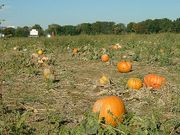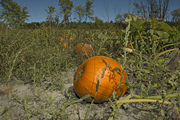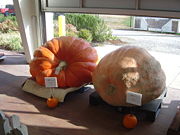Pumpkin
2008/9 Schools Wikipedia Selection. Related subjects: Food
| Pumpkin | ||||||||||||
|---|---|---|---|---|---|---|---|---|---|---|---|---|
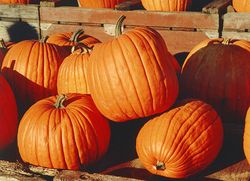 |
||||||||||||
| Scientific classification | ||||||||||||
|
||||||||||||
| Species | ||||||||||||
|
C. maxima |
Pumpkin is a gourd-like squash of the genus Cucurbita and the family Cucurbitaceae (which also includes gourds). It can refer to either species Cucurbita pepo or Cucurbita mixta, and sometimes to a specific variety of either the species Cucurbita maxima or Cucurbita moschata.
Description
The word pumpkin originates from the word “pepon” which is Greek for “large melon.” The French adapted this word to “pompon,” which the English changed to “pompion” and later American colonists changed that to the word we use today, “pumpkin.” The origin of pumpkins is not known, although pumpkins are thought to have originated in North America. The oldest evidence, pumpkin-related seeds dating between 7000 and 5500 B.C., were found in Mexico. Pumpkins are a squash-like fruit that range in size (less than 1 pound to over 1000 pounds), shape, colour, and appearance (smooth or ribbed).
Since some squash share the same botanical classifications as pumpkins, the names are frequently used interchangeably. In general, pumpkins have stems which are firmer, more rigid, pricklier, have a +/- 5 degree angle, and are squarer in shape than squash stems which are generally softer, more rounded, and more flared where joined to the fruit.
Pumpkins generally weigh 9–18 lbs (4–8 kg) with the largest (of the species C. maxima) capable of reaching a weight of over 75 lbs (34 kg). The pumpkin varies greatly in shape, ranging from oblate through oblong. The rind is smooth and usually lightly ribbed. Although pumpkins are usually orange or yellow, some fruits are dark green, pale green, orange-yellow, white, red and gray.
Pumpkins are monoecious, having both male and female flowers, the latter distinguished by the small ovary at the base of the petals. These bright and colorful flowers have extremely short life spans, and may only open for as short a time as one day. The colour of pumpkins is derived from the orange pigments abundant in them. The main nutrients are lutein, and both alpha- and beta- carotene, the latter of which generates vitamin A in the body.
Taxonomy
Pumpkin is the fruit of the species Cucurbita pepo or Cucurbita mixta . It can refer to a specific variety of the species Cucurbita maxima or Cucurbita moschata, which are all of the genus Cucurbita and the family Cucurbitaceae.
Distribution and Habitation
Pumpkins are grown all around the world for a variety of reasons ranging from agricultural purposes (animal feed) to commercial and ornamental sales. Out of the seven continents only Antarctica is unable to produce pumpkins, the biggest international producers of pumpkins include the United States, Mexico, India, and China. The pumpkin capital of the world is Morton, IL. The traditional American pumpkin is the Connecticut Field variety.
Although native to the Western hemisphere, pumpkins are cultivated in North America, continental Europe, Australia, New Zealand, India and some other countries. The pumpkin is the state fruit of New Hampshire.
Ecology
Cultivation in the US
As one of the most popular crops in the United States, 1.5 billion pounds of pumpkins are produced each year. The top pumpkin producing states in the U.S. include Illinois, Ohio, Pennsylvania, and California. Pumpkins are a warm weather crop that are usually planted in early July. The specific conditions necessary for growing pumpkins require that soil temperatures 3 inches deep are at least 60 degrees Fahrenheit, and soil that holds water well. Pumpkin crops may suffer if there is a lack of water or due to cold temperatures (in this case, below 65 degrees; frost can be detrimental), and sandy soil or soil with poor water filtration. Pumpkins are, however, rather hardy and even if many ;leaves and portions of the vine are removed or damaged, the plant can very quickly re-grow secondary vines to replace what was removed.
Pumpkins produce both a male and female flower; honeybees play a significant role in fertilization. Pumpkins have historically been pollinated by the native squash bee Peponapis pruinosa, but this bee has declined, probably due to pesticide sensitivity, and today most commercial plantings are pollinated by honeybees. One hive per acre (4,000 m² per hive) is recommended by the United States of America (US) Department of Agriculture. If there are inadequate bees for pollination, gardeners often have to hand pollinate. Inadequately pollinated pumpkins usually start growing but abort before full development. An opportunistic fungus is also sometimes blamed for abortions.
Giant Pumpkins
The largest pumpkins are Cucurbita maxima. They were cultivated from the hubbard squash genotype, crossed with kabocha-pumpkin types by enthusiast farmers through intermittent effort since the early 1800s. As such germplasm is commercially provocative, a U.S. legal right was granted for the rounder phenotypes, levying them as constituting a variety, with the appellation " Atlantic Giant." Process ually this phenotype graduated back into the public domain, except now it had the name Atlantic Giant on its record (see USDA PVP # 8500204).
“Weigh-off” competitions for giant pumpkins are a popular festival activity. 460 pounds held the world record for the largest pumpkin until 1981 when Howard Dill(of Nova Scotia) broke the record with a pumpkin near 500 pounds. Dill patented the seeds used to grow this giant pumpkin, deeming them Dill’s Atlantic Giant seeds, and drawing growers from around the world. Howard Dill is accredited for all of the giant pumpkins today, most of which are borne from crossing and re-crossing his patented seed with other varieties. By 1994 the Giant Pumpkin crossed the 1000 pound mark. In September 2007, Joe Jutras (of Rhode Island) obtained the title of world’s largest pumpkin with a 1,689 pound, cream colored fruit. He is currently said to be working on producing a giant orange pumpkin, as orange pumpkins tend to be smaller and have thinner shells, but are more desirable in appearance.
Uses
Cooking
| Pumpkin, raw Nutritional value per 100 g (3.5 oz) |
|||||||||||||||||||||||||||||||||||||||||||||
|---|---|---|---|---|---|---|---|---|---|---|---|---|---|---|---|---|---|---|---|---|---|---|---|---|---|---|---|---|---|---|---|---|---|---|---|---|---|---|---|---|---|---|---|---|---|
| Energy 10 kcal 60 kJ | |||||||||||||||||||||||||||||||||||||||||||||
|
|||||||||||||||||||||||||||||||||||||||||||||
| Percentages are relative to US recommendations for adults. Source: USDA Nutrient database |
|||||||||||||||||||||||||||||||||||||||||||||
Pumpkins are very versatile in their uses for cooking, from the fleshy shell, to the seeds, to even the flowers, most parts of the pumpkin are edible. Traditionally, pumpkin is a very popular Halloween and Thanksgiving staple. Although most people use store bought canned pumpkin, home-made pumpkin puree can serve the same purpose.
When ripe, the pumpkin can be boiled, baked, steamed, or roasted. Often, it is made into various kinds of pie which is a traditional staple of the Canadian and American Thanksgiving holiday. Pumpkins that are still small and green may be eaten in the same way as the vegetable marrow/ zucchini. Pumpkins can also be eaten mashed or incorporated into soup. In the Middle East, pumpkin is used for sweet dishes; a well-known sweet delicacy is called halawa yaqtin. In South Asian countries like India, pumpkin is cooked with butter, sugar, and spices; this dish is called kadu ka halwa. In Australia, pumpkin is often roasted in conjunction with other vegetables. In Japan, small pumpkins are served in savory dishes, including tempura. In Thailand, small pumpkins are steamed with custard inside and served as a dessert. In Italy it can be used, with cheeses, as a savory stuffing for ravioli. And also, pumpkin can be used to flavor both alcoholic and nonalcoholic beverages.
Pumpkin seeds
Pumpkin seeds, also known as pepitas, are small, flat, green, edible seeds. Most pumpkin seeds are covered by a white husk, although some pumpkin varieties produce seeds without them. Pumpkin seeds are a popular snack that can be found hulled or semi-hulled at most grocery stores, however, roasting pumpkin seeds (usually scooped out of jack-o-lanterns) is a popular Halloween treat. Pumpkin seeds have many health benefits, some of which include a good source of protein, zinc and other vitamins, and are even said to lower cholesterol. One gram of pumpkin seed protein contains as much tryptophan as a full glass of milk.
Pumpkin seed oil
Pumpkin seed oil is a thick, green oil that is produced from roasted pumpkin seeds. When used for cooking or as a salad dressing, pumpkin seed oil is generally mixed with other oils because of its robust flavor. It is used in cooking in central and eastern Europe, and long believed to be a folk remedy for prostate problems, has in fact been shown to combat benign prostatic hyperplasia.
Pumpkin as a term of affection
"pumpkin" may also be used as a pet name or nick-name between lovers. The name implies that one indidividual loves another individual very very much. Te amo mi amor.
Activities involving pumpkins
Halloween
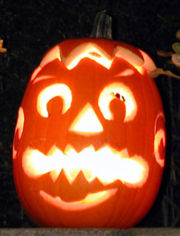
Pumpkins are commonly carved into decorative lanterns called jack-o'-lanterns for the Halloween season in North America. Throughout Britain and Ireland, there is a long tradition of carving lanterns from vegetables, particularly the turnip, mangelwurzel, or swede. But not until 1837 does jack-o'-lantern appear as a term for a carved vegetable lantern, and the carved lantern does not become associated specifically with Halloween until 1866. Significantly, both occurred not in Britain or Ireland, but in North America. Historian David J. Skal writes,
- Although every modern chronicle of the holiday repeats the claim that vegetable lanterns were a time-honored component of Halloween celebrations in the British Isles, none gives any primary documentation. In fact, none of the major nineteenth-century chronicles of British holidays and folk customs make any mention whatsoever of carved lanterns in connection with Halloween. Neither do any of the standard works of the early twentieth century.
In America, the carved pumpkin was first associated with the harvest season in general, long before it became an emblem of Halloween.
Chucking
Pumpkin chucking is a competitive activity in which teams build various mechanical devices designed to throw a pumpkin as far as possible. Catapults, trebuchets, ballistas and air cannons are the most common mechanisms. Some pumpkin chuckers breed and grow special varieties of pumpkin under specialized conditions in order to improve the pumpkin's chances of surviving a throw.
Pumpkin festivals and competitions
Pumpkin growers often compete to see whose pumpkins are the most massive. Festivals are often dedicated to the pumpkin and these competitions.
Circleville, Ohio, holds a big festival each year, the Circleville Pumpkin Show. Half Moon Bay, California, holds the annual Pumpkin and Arts Festival, drawing over 250,000 visitors each year and including the World Champion Pumpkin Weigh-Off. Farmers from all over the west compete to determine who can grow the greatest gourd. The winning pumpkin regularly tops the scale at more than 1200 pounds. The world record pumpkin in 2007 was 1689 pounds, grown by Joe Jutras in Topsfield, Massachusetts.
Morton, Illinois, the self-declared pumpkin capital of the world, has held a Pumpkin Festival since 1966. The town, where Nestlé's pumpkin packing plant is located (and where 90% of canned pumpkins eaten in the US are processed) carved and lit pumpkins in one place, a record which the town held for several years before losing it to Boston, Massachusetts in 2006. A large contributor of pumpkins to the festival is local Keene State College which hosts an event called "Pumpkin Lobotomy" on their main quad. Usually held the day before the festival itself, Pumpkin Lobotomy has the air of a large party, with the school providing pumpkins and carving instruments alike (though some students prefer to use their own) and music provided by college radio station, WKNH.

